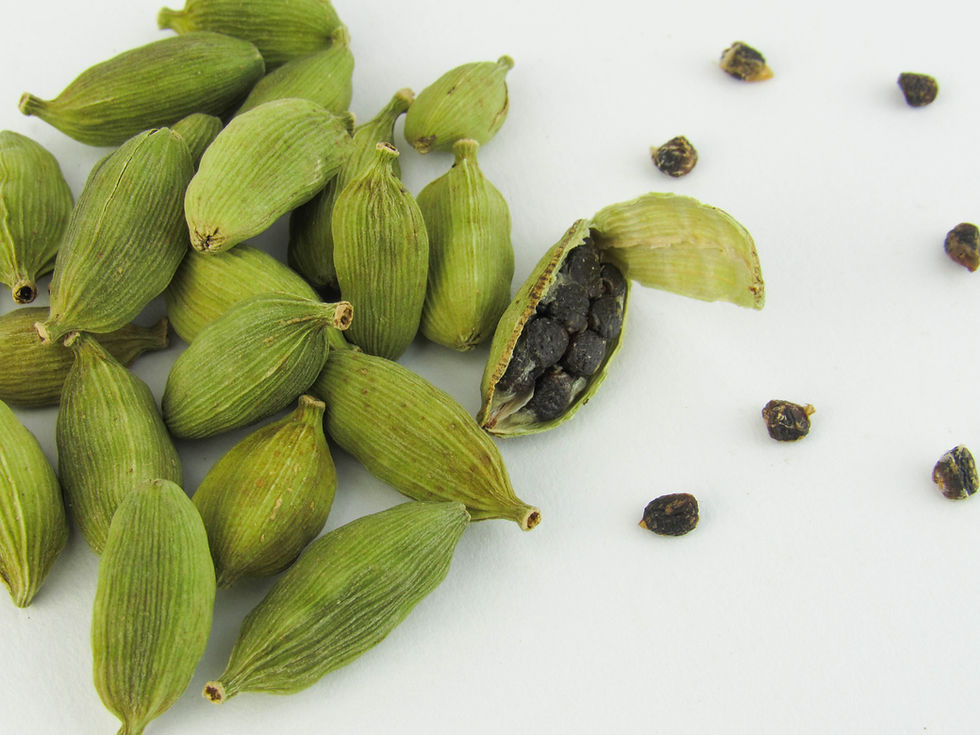What to do with...Cardamon
- Feb 3
- 4 min read
Updated: Feb 24

Cardamom has a rich and global history that spans thousands of years and continents. References of it have been found on tablets as far back as 2000 BCE in Sumaria. The Vikings, given their extensive travels introducing Cardamon to northern Europe - it is a popular ingredient to this day in baked buns in Scandinavia.
Native to the lush forests of southern India, Nepal, and Bhutan, this aromatic spice was revered in ancient Ayurvedic texts not only for its distinctive flavour but also for its medicinal properties. In India, where cardamom is known as elaichi, it has long been an essential element in both culinary traditions and traditional medicine. Traditionally it was used as a breath freshener, containing an oil named cineole, renowned for its antimicrobial qualities.
As early trade routes expanded, cardamom found its way into the bustling markets of the Middle East, where it was embraced by Arab traders and became a symbol of luxury and refinement. The spice’s journey continued westward, captivating the Greeks and Romans alike. These ancient civilisations imported cardamom to enhance their cuisines and to exploit its therapeutic benefits, solidifying its status as a prized commodity.

During the Middle Ages, cardamom played a significant role in the spice trade that connected Asia with Europe. Its introduction into European kitchens spurred new culinary experiments, blending seamlessly with both savoury dishes and sweet confections. The spice’s allure was so profound that it helped fuel the age of exploration, with European traders seeking direct routes to its exotic origins.
Today, while India remains a major producer, cardamom cultivation has spread to other parts of the world, including Guatemala, which has emerged as one of the leading exporters. Despite modern advancements in agriculture and trade, the legacy of cardamom endures. From its ancient roots in traditional medicine to its contemporary role in gourmet cooking, cardamom continues to enchant and inspire, standing as a testament to the enduring power of nature’s bounty.
Cardamom pairs beautifully with a variety of flavours. Some pairing example:
Spices: Cinnamon, cloves, ginger, and nutmeg.
Fruits & Citrus: Orange, lemon, plums, apricots, apples and pears.
Sweet Flavours: Vanilla, almond and chocolate.
Savoury Dishes: Combined with cumin, coriander and saffron in rice dishes and curries.
Beverages: It enhances both coffee and tea, adding a unique aromatic note.
These pairings can help you experiment whether you're baking, cooking savoury meals, or creating your own signature beverage.
Spices: Cardamom is a spice that elevates both sweet and savoury dishes with its unique and aromatic flavour. It finds a natural harmony when combined with other warming spices such as cinnamon, cloves, ginger, and nutmeg, which are essential in many traditional chai blends. This seamless blend of spices not only enhances the overall taste but also contributes to a comforting and complex flavour profile in a variety of recipes.
Fruit: The versatility of cardamom extends to fruits as well. When paired with citrus fruits like orange and lemon, or with milder fruits such as apples and pears, cardamom adds an intriguing layer of flavour that brightens the dish without overwhelming it. Its ability to complement both tart and sweet notes makes it a popular choice in dessert recipes.
Apricots in a cardamon syrup with cream and pistachios
Poach: Apricots for 15 minutes with cardamon seed and a sugar or honey syrup
Reduce: Remove apricots and reduce syrup until slightly jammy in texture.
Serve: Spoon syrup over Apricots and add whipped cream mixed with vanilla and sprinkle over crushed pistachios.
In the realm of sweets, cardamom shines when combined with flavours like vanilla, almond, or even chocolate. Its distinctive taste can transform a simple dessert into an exotic treat, offering a delightful twist that surprises the palate. The spice’s subtle heat and complexity make it an ideal addition to a wide range of confections, from cookies to custards.
Chocolate Chip cookies with Cardamon
Add: 1 tsp of ground cardamon to your chocolate cookie recipe.
Cardamom also plays an important role in savory cooking, especially in Middle Eastern and Indian cuisines. It is often used alongside other bold spices such as cumin, coriander, and saffron in rice dishes and curries. In these culinary traditions, cardamom contributes to a balanced, fragrant, and richly layered flavour profile that is both comforting and invigorating.
A South Asian recipe for a simple Chicken Curry using Cardamon
Cook Chicken: Brown chicken and remove.
Sauté spices: Heat oil. Add 5 cardamon, a bay leaf and 1/2 tsp cinnamon, . Add tsp cumin, then onion. Sauté until golden. Then add garlic, ginger, turmeric, chili powder, coriander. Stir. Add tomato puree. Simmer.
Creaminess: Add Chicken and coconut milk. Simmer until cooked.
Finish: Add garam masala. Stir. Garnish with coriander.
Even in beverages, cardamom offers its signature aromatic qualities. Whether added to coffee or tea, it transforms ordinary drinks into flavourful experiences, imparting a hint of exotic spice that can make your daily cup of coffee or tea feel like a luxurious ritual. Overall, cardamom is a truly versatile spice that invites creativity, enhancing dishes and drinks with its remarkable and multifaceted flavour.


